|
The DoveSong MP3 Library
is
no longer in Service
Popular
Music of the 1940s and Early 1950s |
1954:
The Golden Year of Popular Music:
It was All About Love, Folks!
Pop
music reached its zenith in 1954, the same year that America's
first rock and roll tune, Rock
Around the Clock, made its debut.
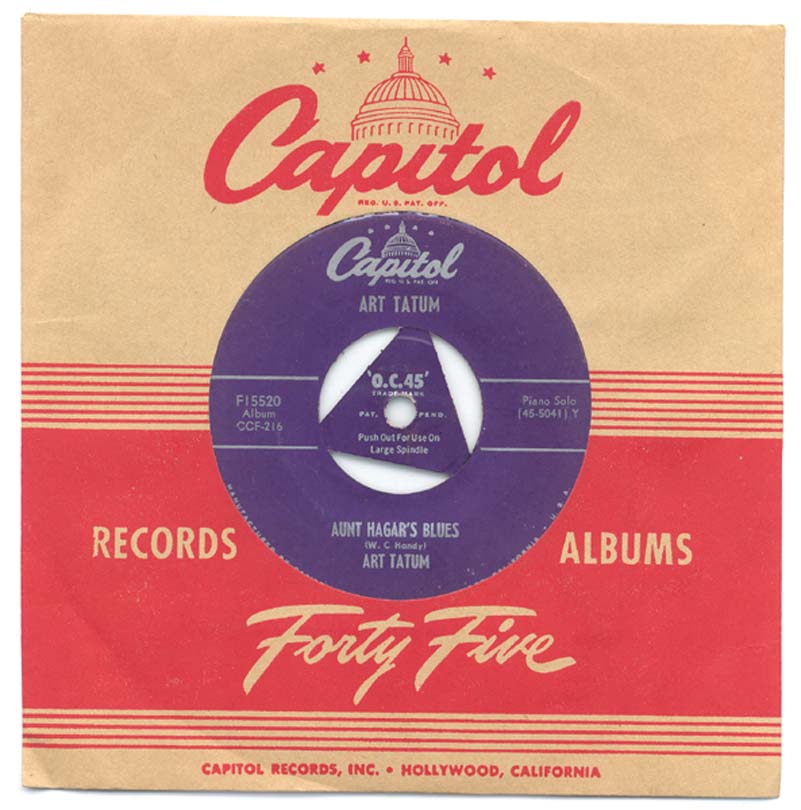
Secret
Love sung by Doris Day. Columbia 40108. This beautiful song
reached number 1 on January 9, 1954 and remained on the
charts for nearly a half a year.
Little
Things Mean a Lot sung by Kitty Kallen. Decca
29037. This
great record reached Number 1 on the charts on April 17, 1954
and saw a half year on the Billboard charts. Miss Kallen so
believed in this song and in "Chapel in the
Moonlight," that she financed the recording sessions
herself. Her label, Decca, refused to pay for the sessions
because they saw no commercial value in these songs. Little
Things Mean a Lot was the
biggest selling and most popular record of the Golden year 1954, when
popular music reached its peak.
In
the Chapel in the Moonlight sung by Kitty Kallen,
this great record reached Number 5 on the charts on July 17,
1954. See the note above. Decca 29130.
From
the Vine Came the Grape sung by the Gaylords.
Mercury 70296. Reached Number 8 on February 6.
The
Isle of Capri sung by the Gaylords. Mercury
70350. Reached Number 15 on May 15.
Hey
There sung by Rosemary Clooney. Columbia 40266.
Hey There, from the Broadway play Pajama Game, was the
second biggest hit of 1954.
Hernando's
Hideaway
by Archie Bleyer. Cadence 1241. Reached Number 2 in 1954. From
the
Broadway play Pajama Game.
Naughty
Lady of Shady Lane
by Archie Bleyer. Cadence 1254. Skokian
played by the Bulawayo Sweet Rhythm Boys. London 45-1491. This
instrumental was a first a hit in its native country of
Africa. It was released in England, then after becoming a hit
there, came to America to reach Number 17 on the Billboard
charts on August 28, 1954.
Cara
Mia sung by David Whitfield. London 1486. What a tremendous
song that came to us from England written by
Mantovani. Reached Number 10 on the 14th of August.
If
You Love Me, Really Love Me (Really Love Me) sung by Vera
Lynn. London 1412. What a great song from England.
Three Coins in the Fountain
sung by the Four Aces. Decca 29123. Reached Number 2 on May
22.
The
Happy Wanderer
played by Frank Wier's Orchestra. London 1448. Reached Number 4
on May 1st. It was first a hit in Frank Wier's country of
England.
The
Man with the Banjo by the Ames Brothers. RCA 20-5644.
Reached Number 7 on April 3rd.
I
Get so Lonely
by the Four Knights. Capitol 2654.
This
Ole House sung and written by Stuart Hamblen. Victor
20-5739.
Carefree
by Wayne King. Decca 9-29500. played by Wayne King's Orchestra.
If I Give My Heart to You sung by Doris Day. Columbia
40300. This tremendous love song reached Number 4 in
September.
Leroy
Anderson's Instrumentals
Compositions
by Leroy Anderson. Unless otherwise noted, orchestra conducted
by the composer.
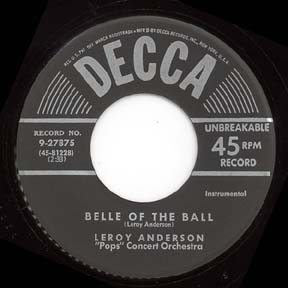
Blue
Tango Decca 9-27875. Blue Tango conducted by
Leroy Anderson was the Number 1 chart-topping song of
1952!. In fact, it is the 5th longest-running song (tied
with So Rare and Why Me (Lord)) from the 1940 -
1979 period. It enjoyed 38 weeks (Almost 10 months) on the
charts! My, how times have changed.....
Blue Tango played by Les Baxter's orchestra. Capitol
F-1966.
First
Day of Spring Decca
Plink,
Plank, Plunk Decca 9-28168
Plink,
Plank, Plunk played by Florian Zabach.
Decca 28916
Saraband
Decca 9-28429
Sleigh Ride Decca 9-28429
Fiddle
Faddle Decca 9-28300
Jazz
Pizzicato/Jazz Legato Decca
Forgotten
Dreams Decca 9-30403
Belle
of the Ball Decca 9-27875
Instrumentals
by David
Carroll
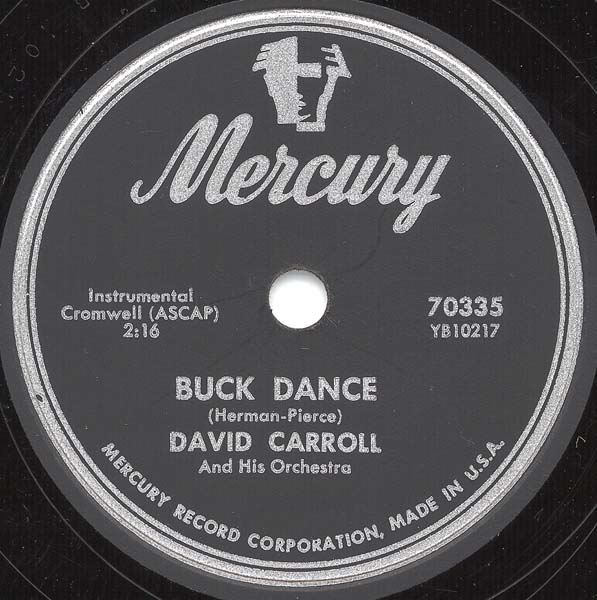
Buck
Dance played by the David Carroll Orchestra. Mercury
70335
Fancy
Pants played by the David Carroll Orchestra. Mercury
70292
Mine
played by the David Carroll Orchestra. Mercury 70412
Cornsilk
played by the David Carroll Orchestra. Mercury. (Cornsilk
played by the Wayne King Orchestra. Victor 26424.
1939)
Grandpa's
Rocker played by the David Carroll Orchestra. Mercury
70412
The
"String" Instrumentals
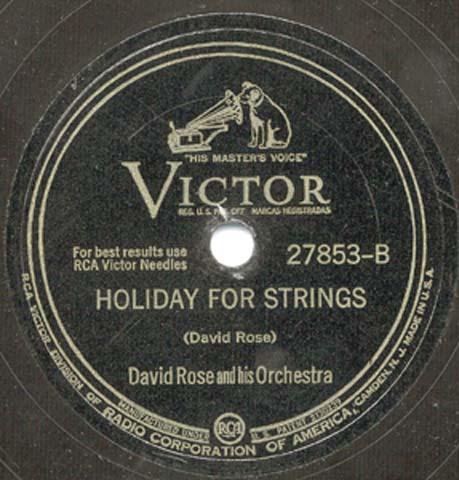
Holiday
for Strings composed by David Rose. Played by David
Rose's Orchestra. Victor 27853. Reached Number 2 on the charts
on February 19, 1944. This was the first of the great
instrumentals that made use of the sounds of the string
section of the orchestra
Picnic
for Strings composed by Malcomb Lockyer.
Orchestra conducted by the composer. Mercury 70383
No
Strings Attached played by the Boston Pops, Arthur
Fielder, conductor. RCA 49-3890. This tune was written by Richard
Hayman, who had his own recording on Mercury. Like Leroy
Anderson, Hayman was also an arranger for the Boston Pops when
he first started out.
Tic-Tac-Toe played by Hugo Winterhalter's Orchestra. RCA
47-4851
Vanessa
played by Hugo Winterhalter's Orchestra. RCA 47-4691. This
beautiful record reached Number 12 on the charts on July 12,
1952.
The
Magic Touch played by Hugo Winterhalter's Orchestra. RCA
47-5209
Flirtation
Waltz played by Frank Chacksfield and his Orchestra.
London 45-1406
It's
Only a Paper Moon played by the David Rose Orchestra.
MGM K30850
Curtain Time played by Acquaviva's Orchestra. MGM
30668. Acquaviva was singer Joni James' husband.
Other Great Instrumentals of the Early Fifties
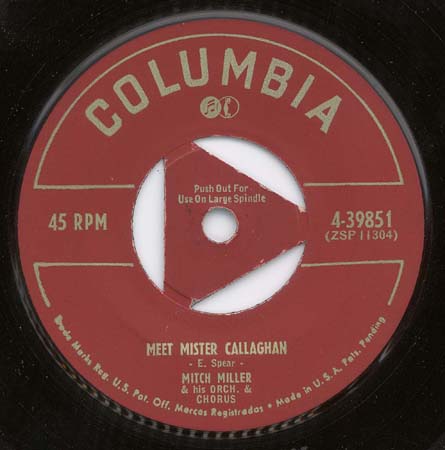
Meet
Mr. Callaghan
played by Mitch Miller's Orchestra. Columbia 4-39851. This was
Mitch Miller before he became commercial. What a great
arrangement, using harpsichord
Under
Paris Skies (Sous Le Ciel Du Paris) played by Mitch Miller's Orchestra.
From the French Film Sous Le Ciel Du Paris. Columbia
4-40100. Notice the subtle effects of orchestration such as a female voice and flute on the same melody together.
Lisbon
Antigua played by Nelson Riddle's Orchestra. Capitol
3287. This was the Number 1 chart-topping song of 1956 (Heartbreak
Hotel was Number 6).
Port-Au-Prince
played by Nelson Riddle's Orchestra. Capitol 3374. The
follow-up single to Lisbon Antigua
Aviva
by Barclay Allen. Imperial 40004. Barclay Allen, from Denver,
was a great pianist and tunesmith. This tremendously talented
man's career was halted in 1949 when he was injured in a very
bad car accident. This is a great record, embodying the
positive energy that flowed through music of the period.
Melody
of Love The Billy Vaughn Orchestra. Dot 15247. Billy
Vaughn's remake of this Wayne King classic reached Number 2 on the charts in December 1954 and spawned
a number of 'covers' by a number of artists. (Melody
of Love Victor 27713. This is Wayne King's original
version from 1941)
Charmaine
played by Mantovani Orchestra. London 1020. This hit
recording from England reached Number 10 on the charts in
1951.
The
Lazy Gondolier
played by Mantovani Orchestra. London 45-1510.
Julie's
Jump
by Archie Bleyer. Cadence 1320.
Amber
by Archie Bleyer. Cadence 1320.
Delicado
played by the Percy Faith orchestra. Columbia 4-39708. Reached
Number 1 on the Billboard charts on April 26, 1952 and
remained on the charts 22 weeks.
Dream
Rhapsody played by Leonard Pennario and Les Baxter's
orchestra. Capitol F3599. This is an adaptation by Les Baxter
of one of the melodies from the Second
Movement of the Symphony in D Minor by French Composer Cesar
Frank.
Pretend
by Ralph Marterie's Orchestra. Mercury70045. Reached Number 16
on the charts on February 14, 1953.
One
Fine Day by Ralph Marterie was an adoption of an Aria
(Un Bel Dia) from Pucinni's opera Madame Butterfly.
Mercury 70655
Ruby
by Richard Hayman.
Mercury 70115. Reached Number 3 in April, 1953.
Other
Songs of the Era
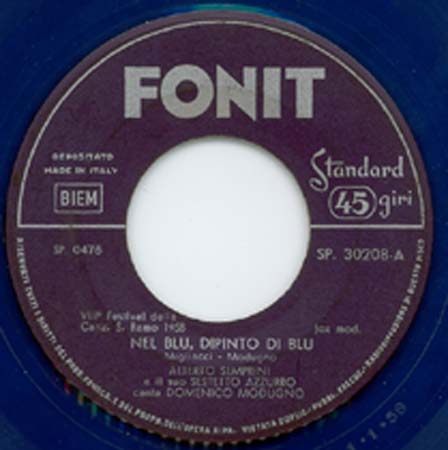
Nel
Blu Dipinto Di Blu Sung by Domenico Modugno. Decca
30677. I was traveling in Italy during July of 1958 and I
heard this great song playing from every juke box, every
radio. I adored this song and music being my great
passion, I had to have a record for my own. In a little record
shop in Riminni, on the eastern shore of Italy, I bought a
copy from a beautiful young Italian girl. It was on the Fonit
label. I made a vow that when I returned to the United States,
I would take my record to the disk jockeys in my home town of
Denver, so that it could be discovered there also. The first
music that I heard when I arrived at the airport in New York
City was this song playing in the Airport. I was shocked to
find it had made its own way overseas to my home country. Nel
Blue Dipinto Di Blue ("Volare") reached Number One
on the charts in the USA on August 4, 1958. (Story from Don
Robertson)
Ballerina sung by
Vaughn Monroe. RCA Victor 20-2433.
Reached Number 1 in November, 1947.
Nature
Boy sung by Nat King Cole. Capitol 15054.
Reached Number 1 on the charts on April 24, 1948. Great song
written by a long-haired "mystic" who showed up back
stage after one of Nat's Los Angeles performances.
The
Loveliest Night of the Year Mario Lanza. RCA 49-3300.
Charted in 1951. A beautiful song.
Be
My Love sung by Mario Lanza. RCA 49-1353. Reached the
charts in 1950.
Blue
Skies sung by Doris Day. 1940s
Sweet
Violets sung by Dinah Shore. RCA Victor
20-4174. 1951
Dear
Hearts and Gentle People sung by Dinah Shore.
Columbia 38605. 1949.
The
Donkey Saranade sung by Allan Jones.
From the late 1930s, was popular in the 1940s as well.
The
Banjo Revival
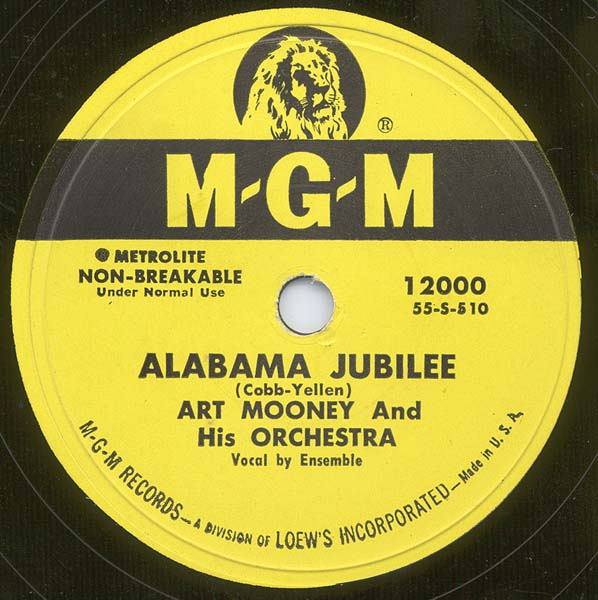
I'm
Looking Over a Four-Leaf Clover played by Art Mooney's
orchestra. MGM 10119. Reached Number One on the Billboard chart
of January 24, 1948 and started a revival of
"old-time" tunes that featured the banjo.
Baby
Face played by Art Mooney's
orchestra. This was the 1948 follow-up to I'm Looking Over a
Four-Leaf Clover. MGM 10156
Alabama
Jubilee by played by Art Mooney's orchestra. MGM 12000.
1955.
The
Banjo's Back in Town
by Sammy Kaye. Columbia 4-40517. 1955.
Hey
Mr. Banjo
by The Sunnysiders. Kapp K-113. This song reached Number 20 on the
charts in May, 1955.
It's
a Sin to Tell a Lie
by Somethin' Smith and the Redheads. Epic 9093. 1955.
The
Man with the Banjo
by the Ames Brothers. RCA20-5644. Reached Number 7 on April 3rd,
1955.
|
Another
Viewpoint:
"You guys are
nuts. Although there were some good vocals in the late
1940s and even early 1950s, popular music went into
decline about 1945. No one who lived through the
big-band era - when the Dorseys, Glenn Miller, Harry
James, Woody Herman, the Ink Spots, the Mills Brothers,
Ella Fitzgerald, etc. were at their peak - would think
that better music was produced in the 1950s.
From Bogard |
|

